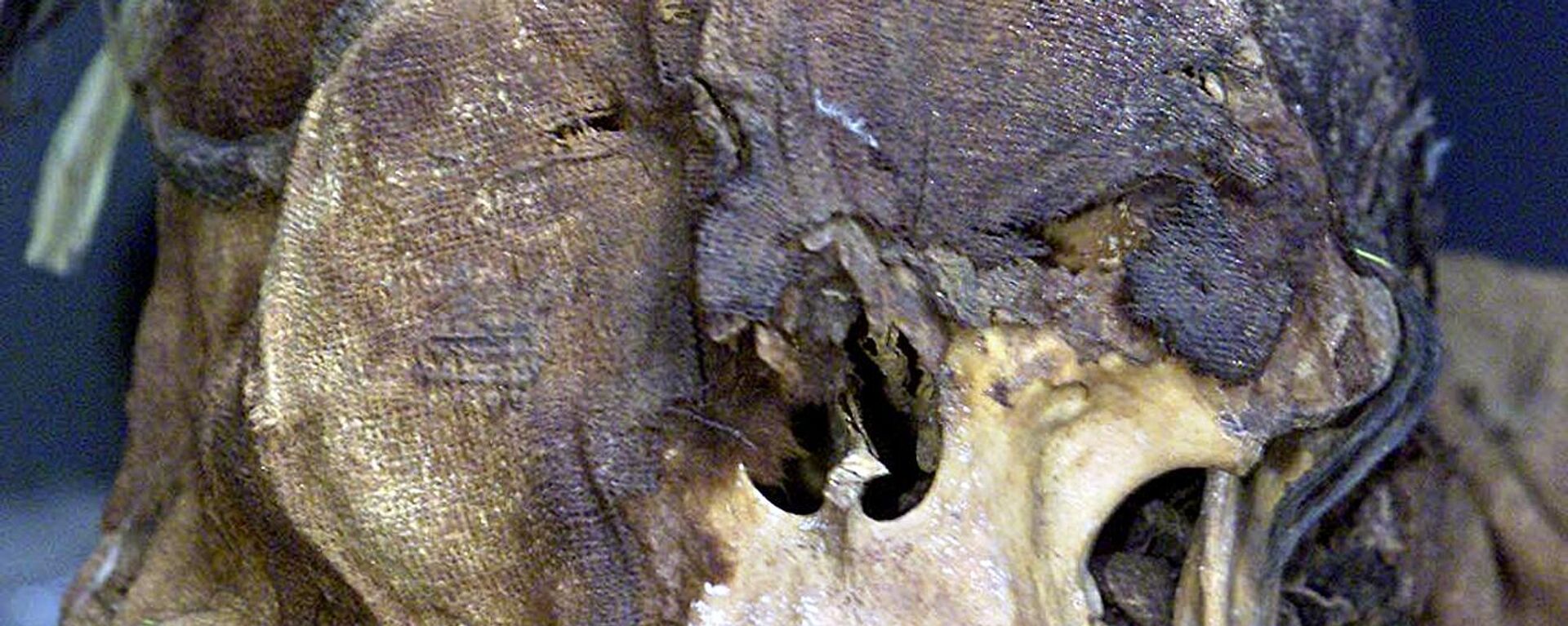https://sputnikglobe.com/20230615/ancient-sacrifice-peruvian-archaeologists-discover-3000-year-old-mummy-1111183217.html
Ancient Sacrifice: Peruvian Archaeologists Discover 3,000-Year-Old Mummy
Ancient Sacrifice: Peruvian Archaeologists Discover 3,000-Year-Old Mummy
Sputnik International
In a remarkable archaeological find, Peruvian archaeologists unearthed the remains of a mummy estimated to be around 3,000 years old.
2023-06-15T12:52+0000
2023-06-15T12:52+0000
2023-06-15T13:10+0000
peru
lima
mummy
remains
archeology
beyond politics
https://cdn1.img.sputnikglobe.com/img/07e7/06/0f/1111185319_0:160:3072:1888_1920x0_80_0_0_0568ab6f99a1d156daf696fbe9590df7.jpg
In a remarkable find, Peruvian archaeologists unearthed the remains of a mummy estimated to be around 3,000 years old.It was discovered by a team of students from the National University of San Marcos and dedicated researchers. During an excavation, the scholars first came across strands of hair and a skull in a bundle of cotton. Their curiosity piqued, and so they continued their careful digging, leading to the remarkable revelation of a complete mummy.According to archaeologist Miguel Aguilar, the mummy is believed to be from the Manchay culture, which flourished in the valleys of Lima between 1500 and 1000 BC. This culture was known for building temples in a U-shape, intentionally aligned with the sunrise.In addition to the preserved body, archaeologists discovered a number of other associated artifacts buried with the mummy. Notable among these finds were corn, coca leaves, and various seeds, leading the researchers to theorize that these items may have served as offerings accompanying the deceased.Thriving between 1500 and 1000 BC, the Manchay inhabited the valleys of Lima and left fascinating remnants of their existence, including the aforementioned temples. The mummy discovered in Lima not only sheds light on their ancient culture, but also deepens the understanding of the elaborate rituals and beliefs that prevailed during that era.
https://sputnikglobe.com/20230301/she-sleeps-with-me-i-take-care-of-her-peruvian-man-caught-carrying-ancient-mummy-in-delivery-bag-1107889773.html
peru
lima
Sputnik International
feedback@sputniknews.com
+74956456601
MIA „Rossiya Segodnya“
2023
Sputnik International
feedback@sputniknews.com
+74956456601
MIA „Rossiya Segodnya“
News
en_EN
Sputnik International
feedback@sputniknews.com
+74956456601
MIA „Rossiya Segodnya“
Sputnik International
feedback@sputniknews.com
+74956456601
MIA „Rossiya Segodnya“
peru, lima, pre-hispanic artifacts, mummy, andes, andean states, mummy found in peru, national university of san marcos
peru, lima, pre-hispanic artifacts, mummy, andes, andean states, mummy found in peru, national university of san marcos
Ancient Sacrifice: Peruvian Archaeologists Discover 3,000-Year-Old Mummy
12:52 GMT 15.06.2023 (Updated: 13:10 GMT 15.06.2023) The discovery, announced on Wednesday, adds to the growing collection of intricate pre-Hispanic artifacts discovered in the Andean nation.
In a remarkable find, Peruvian archaeologists unearthed the remains of a mummy estimated to be around 3,000 years old.
It was discovered by a team of students from the National University of San Marcos and dedicated researchers. During an excavation, the scholars first came across strands of hair and a skull in a bundle of cotton. Their curiosity piqued, and so they continued their careful digging, leading to the remarkable revelation of a complete mummy.
According to archaeologist Miguel Aguilar, the mummy is believed to be from the Manchay culture, which flourished in the valleys of Lima between 1500 and 1000 BC. This culture was known for building temples in a U-shape, intentionally aligned with the sunrise.
"It is likely that this individual was intentionally left behind or offered as a sacrifice during the final phase of the construction of this temple. Based on our analysis, we estimate that this mummy is approximately 3,000 years old," the archaeologist explained.
In addition to the
preserved body, archaeologists discovered a number of other associated artifacts buried with the mummy. Notable among these finds were corn, coca leaves, and various seeds, leading the researchers to theorize that these items may have served as offerings accompanying the deceased.
Thriving between 1500 and 1000 BC, the Manchay inhabited the valleys of Lima and left fascinating remnants of their existence, including the aforementioned temples. The mummy discovered in Lima not only sheds light on their ancient culture, but also deepens the understanding of the elaborate rituals and beliefs that prevailed during that era.



